Top 10 Birds Of Prey
While every bird of prey is impressive, these beaked beauties soar above the rest. Prepare to take flight as we meet the largest, fastest, rarest and most powerful raptors in the world!
There are approximately 10,000 species of bird on the planet, ranging from tiny hummingbirds to imposing ostriches. Among these avian wonders, an elite group has consistently fascinated and Inspired humankind more than any other: the raptors.
These impressive flying predators, commonly known as birds of prey, are characterized by their talent for hunting larger vertebrates than most birds are capable of killing.
Each species of raptor has a particular set of specialisms, helping them to hunt, breed and survive in their chosen habitat. Large raptors like eagles dominate the food chain by using powerful wings, large talons and brute strength to overwhelm their prey. Other raptors, such as owls, use stealth to their advantage; keen senses, quiet movement and the cover of night allow these nocturnal birds of prey to thrive where others would struggle.
Despite their seemingly invincible anatomies, raptors aren’t immune to the human dangers that plague wildlife worldwide. Many birds of prey are endangered, some critically, although there is some cause for hope; conservation efforts have proven that raptors are resilient enough to repopulate their old territories and soar through the skies once more if given enough support.
We bring you some of the world’s most remarkable raptors and the unique adaptations that allow them to rule the roost.
Crowned eagle
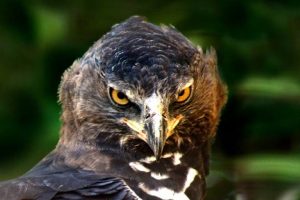 While many raptors are known for their strength and ferocity, the crowned eagle is the most powerful. This striking African eagle dominates the forests it lives in, preying on mammals and reptiles up to five times its size and weight. It relies on a number of brutal killing strategies to take down prey: some victims have their spines snapped by the eagle’s large hind daw, while others may have their skull crushed within its vlce-like talons.
While many raptors are known for their strength and ferocity, the crowned eagle is the most powerful. This striking African eagle dominates the forests it lives in, preying on mammals and reptiles up to five times its size and weight. It relies on a number of brutal killing strategies to take down prey: some victims have their spines snapped by the eagle’s large hind daw, while others may have their skull crushed within its vlce-like talons.
Among the crowned eagle’s most noteworthy prey are antelope such as buckbucks and duikers – this raptor is capable of killing ungulates weighing up to 30 kilograms (66.1 pounds), tearing apart their bodies and carrying away chunks of flesh to eat over the course of several days.
Smaller prey species include monkeys, mongooses, feral cats, rodents, monitor lizards and even venomous snakes. One of the eagle’s favourite hunting methods involves waiting silently in trees for unsuspecting animals to drop down on, then snatching their prey from the ground and carrying it up into the treetops to feed on it safely away from any ground-based scavengers.
The crowned eagle’s fierce nature can be observed from a young age. If two chicks are born in a clutch, the stronger of the pair will often kill its sibling, thereby immediately eliminating competition for food.
Black-thighed falconet
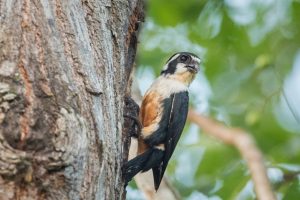 While many raptors are impressively large, others are adorably tiny. The black-thighed falconet’s diminutive dimensions make it the smallest bird of prey at a mere 17 centimeters (6,7 inches) in length.
While many raptors are impressively large, others are adorably tiny. The black-thighed falconet’s diminutive dimensions make it the smallest bird of prey at a mere 17 centimeters (6,7 inches) in length.
It might be cute, but looks can be deceiving. The black-thighed falconet’s hunting skills make it a frightening prospect for the insects, lizards and birds it feeds on. Unlike most birds of prey, falconets hunt in groups, scouring forests, rivers and human-inhabited areas for smaller creatures to snack on.
The falconet’s small size means it’s able to take advantage of ready-made nest holes – these raptors frequently roost in holes previously occupied by barbets or woodpeckers, laying and incubating small clutches of eggs inside them.
Peregrine falcon
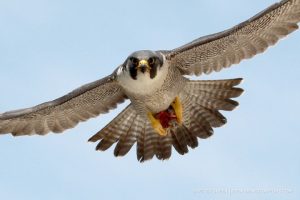 Built for speed, the peregrine falcon’s anatomy allows it to fly at an unbelievable pace.
Built for speed, the peregrine falcon’s anatomy allows it to fly at an unbelievable pace.
The peregrine falcon isn’t just the fastest raptor – this bird’s 200-mile-per-hour (321.9-kilometre-per-hour) nosedive means it is widely considered to be the quickest animal on Earth!
Peregrine falcons can be found on every continent except Antarctica. They’re a common sight worldwide, but it wasn’t always this way. The pesticide DDT almost wiped these impressive birds out in the 1960s, poisoning them and preventing successful breeding due to the unnatural thinning of their eggshells. Thankfully, DDT was banned in the 1970s, and peregrines have been thriving ever since.
These falcons are among the most recognizable urban birds, often making their nests on skyscrapers and other tall buildings while patrolling the skies in search of pigeons to feed on. Once they’ve settled in a spot, peregrine falcons prefer to stay put; some populations have returned to the same nesting sites for hundreds of years.
Almost everything about the peregrine’s anatomy is built for speed. Its large keel (a modified breastbone specialized for flight) allows extra muscle and flapping power, while its pointed wings and slim feathers make it extremely aerodynamic, its respiratory system has also evolved to handle breakneck speeds, with specially adapted air sacs and a strong, rapid heartbeat that keep its body oxygenated at twice the flying speed most birds can handle.
Andean condor
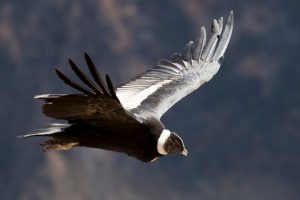 Two birds could potentially be considered Earth’s largest raptor. Wingspan is often considered the most notable size characteristic for birds, and by this logic the largest raptor is the Andean condor. But the title goes to a different bird if you’re measuring from beak-to-tail: the California condor is five centimeters longer than its Andean cousin.
Two birds could potentially be considered Earth’s largest raptor. Wingspan is often considered the most notable size characteristic for birds, and by this logic the largest raptor is the Andean condor. But the title goes to a different bird if you’re measuring from beak-to-tail: the California condor is five centimeters longer than its Andean cousin.
Both of these colossal raptors belong to the Cathartidae family, an avian group usually described as New World vultures. At 3.3 meters (10.8 feet), the Andean condor’s wingspan is among the largest on Earth and is exceeded only by a quartet of sea and water birds: the wandering albatross, southern royal albatross, great white pelican and Dalmatian pelican. It’s also the heaviest raptor on Earth, weighing in at a whopping 15 kilograms (33 pounds). For comparison, a common buzzard weighs just over one kilogram (2.2 pounds).
While smaller, the California condor’s 2.9-metre (9.5- feet) wingspan and 10.4-kilogram (22.9-pound) weight are not to be sniffed at and make it the largest flying land bird in North America.
Other than their mighty dimensions, condors can be recognised by their black plumage, white collars and bald heads. Their featherless domes evolved for hygiene purposes, preventing bacteria from scavenged corpses lingering on the body.
Philippine eagle
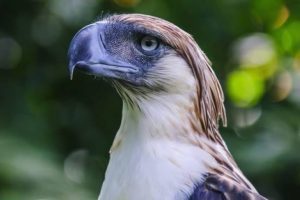 Even the mightiest birds of prey are at serious risk from the damaging activities of humans encroaching on their habitats.
Even the mightiest birds of prey are at serious risk from the damaging activities of humans encroaching on their habitats.
Sadly, there are multiple contenders for the title of rarest raptor. From the forest owlet (an Indian bird that was thought to be extinct for 113 years until it was rediscovered in 1997) to Ridgway’s hawk (a critically endangered species that’s been heavily persecuted by farmers on its native island of Hispaniola), many species are struggling in the fight for survival.
Perhaps the rarest of them all is the Philippine eagle.
Also known as the monkey-eating eagle, this majestic bird was made the national emblem of the Philippines in an effort to raise awareness about Its plight: deforestation from fogging and agriculture have drastically shrunk the size of its habitat, while pollution, pesticides and poaching put the remaining birds at risk. At most, there are thought to be 600 Philippine eagles left in the wild.
Red kite
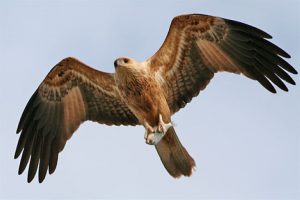 After being persecuted for decades, the red kite’s remarkable comeback is proof that conservation efforts really can make a difference.
After being persecuted for decades, the red kite’s remarkable comeback is proof that conservation efforts really can make a difference.
It’s easy to feel dejected by doom and gloom stories about species on the brink of extinction, but the resurgence of some previously endangered creatures helps to refuel the fires of hope among conservationists. Without a doubt, one of the most impressive examples of conservation success is the red kite.
These now-ubiquitous raptors weren’t always widespread. In the early 1900s the red kite was extinct in many parts of the UK, with only a handful of the birds clinging on in Wales. Thanks to conservation efforts throughout the last century red kites have since bounced back so strongly that their numbers have become too large for the RSPB to accurately survey. They can now be seen in all parts of the UK.
Bald eagle
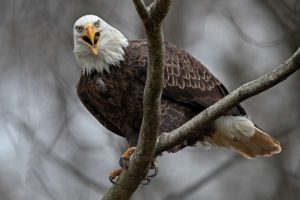 Bald eagles are recognized around the world as symbols of patriotism and power.
Bald eagles are recognized around the world as symbols of patriotism and power.
No animal is as closely linked with the pride and identity of a nation as the bald eagle. An enduring icon for the United States of America, this recognizable raptor continues to be held in regard as a symbol of patriotism and features on official emblems of the US Government.
While the US takes credit for this bird’s world-renowned status, wild bald eagles can also be found in Canada and Mexico. The raptor is considered sacred by some Native Americans, who have been using their feathers to commemorate achievement and honour for many centuries, a right only afforded to those who are part of a recognized tribe according to US law.
Unlike vultures, bald eagles don’t actually have bald heads – their name derives from an older definition of the word meaning ‘white headed’.
Long-eared owl
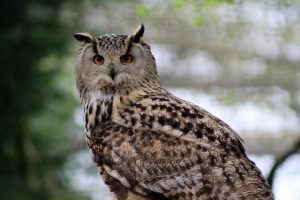 Silent flight allows owls to catch prey without detection.
Silent flight allows owls to catch prey without detection.
As well as possessing night vision and radar-like hearing, owls are renowned for being the stealthiest birds in the animal kingdom. These nocturnal predators are capable of silent flight – their specially adapted feathers convert mechanical energy into heat, preventing noise from escaping their wings and allowing them to swoop in on prey unheard.
During a study comparing pigeon, eagle and long-eared owl feathers, researchers found that despite the similar wingbeats of all three birds, the owl’s feather structure allows it to suppress acoustic noise caused by vibrations that occur during flight. The discovery is inspiring engineers to develop similarly structured noise-reduction devices for loud- but-useful products, such as wind turbines,
Harris’s hawk
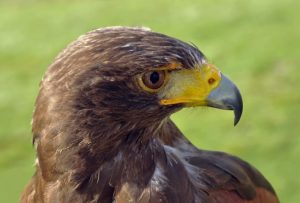 Bucking the lone raptor trend, Harris’s hawks team up to conduct cooperative hunts before sharing the spoils.
Bucking the lone raptor trend, Harris’s hawks team up to conduct cooperative hunts before sharing the spoils.
While most raptors are solitary and prefer to hunt alone, Harris’s hawks are a notable exception to this rule. These intelligent and sociable birds have been described as ‘wolves of the sky’ for their amazing ability to hunt cooperatively, using strategy and teamwork to leave their prey with nowhere to hide.
Each hawk takes on a role suited to its strengths; some rely on incredible vision to spot prey for the group, while the most aerially adept individuals lead the chase. Some hawks excel in flushing prey out of hiding places, while others tactically block holes and nest entrances with their feet. Once the prey has been killed, the hawks continue to be sociable, sharing the meal with their hunting buddies.
Common buzzard
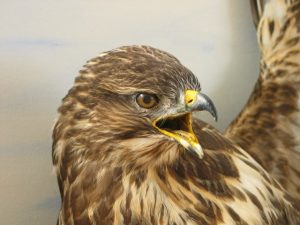 Buzzards are the UK’s most common bird of prey, breeding in every county of England, Wales and Scotland. They’re adept at hunting a wide variety of prey, including rabbits, voles, mice and small birds.
Buzzards are the UK’s most common bird of prey, breeding in every county of England, Wales and Scotland. They’re adept at hunting a wide variety of prey, including rabbits, voles, mice and small birds.
The common buzzard measures between 40 and 58 cm (16 and 23 in) in length with a 109–140 cm (43–55 in) wingspan and a body mass of 427–1,364 g (0.941–3.007 lb), making it a medium-sized raptor.
The common buzzard breeds in woodlands, usually on the fringes, but favours hunting over open land. It eats mainly small mammals, and will come to carrion. A great opportunist, it adapts well to a varied diet of pheasant, rabbit, other small mammals to medium mammals, snakes and lizards, and can often be seen walking over recently ploughed fields looking for worms and insects. (Text by World of Animals – 2018)

Comments are closed.